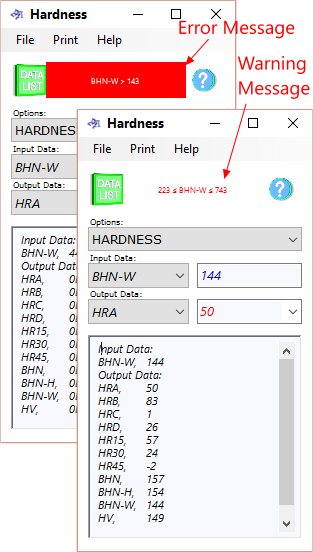Metal (and material) Hardness Calculator
The hardness of most materials, especially metals, can be measured accurately and with reasonable consistency. Moreover, the various testing methods devised over the years can be used to measure the hardness of the same materials but provide different values, dependent upon the technique used. Whilst each technique is usually best suited to particular materials or hardness ranges, they can be (and frequently are) used for comparison purposes. It is for this reason that a comparison between the various scales is perfectly valid.
Our hardness conversion page describes the most commonly used scales along with a description of each test method and a series of formulas that accurately convert between them within a specified range of values. CalQlata has now incorporated these formulas into a calculator that will simultaneously convert your entered scale/value into all the other scales.
Each hardness scale has a validity range (defined by CalQlata) outside which the conversion reliability may (but not necessarily) be suspect. Whilst the hardness calculator provides these ranges and warns you of any entered values that fall outside the range concerned (Fig 1), it will convert any value entered if the calculation is possible.
Hardness Scales
Below is listed the intended application for each scale included in the hardness calculator, albeit there is usually a good deal of overlap between each method regarding fitness for purpose.
Rockwell A:
Very hard materials such as tungsten-carbide, ceramics, hardened carbon and alloy steels
Rockwell B:
Relatively soft metals such as low and medium carbon steels in annealed condition
Rockwell C:
Medium hard metals such as medium carbon steels in normalised or work-hardened condition (metals that fall between Rockwell B and Rockwell A)
Rockwell D:
Metals that are slightly harder than those suited to Rockwell C, such as Case-hardened and low-hardened alloy steels
Rockwell 15-15N:
Used for relatively hard metals, such as those normally suited to Rockwell C, but that must leave only a shallow impression
Rockwell 30-30N:
Used for hard metals, such as those normally suited to Rockwell D, but that must leave only a shallow impression
Rockwell 45-45N:
Used for very hard metals, such as those normally suited to Rockwell A, but that must leave only a shallow impression
Brinell-std:
Used for metals of similar hardness to those suited to Rockwell C above (medium hardness)
Brinell-Hultgren:
Used for metals of similar hardness to those suited to Rockwell D above (hard)
Brinell-tungsten:
Used for metals of similar hardness to those suited to Rockwell A above (high hardness)
Vickers:
Used where high levels of accuracy are required and laboratory conditions are available
Shore:
Used for site measurement where comparison is of greater importance than accuracy
Hardness Calculator – Technical Help

Fig 1. Warning & Error Messages
There is only one calculation option; 'Hardness'
You select the input hardness scale from the drop-down menu under the Input Data:
You enter the hardness value in the adjacent text box
The hardness calculator automatically and instantly lists all the conversions in the data listing window.
If a warning is issued; red text on a white background (Fig 1), this means that the scale listed is outside the recommended range, which is provided in the warning.
If an error is issued; white text on a red background (Fig 1), this means that the scale listed cannot be converted into one or more of the other scales.
Accuracy
This calculator’s accuracy can be seen in the various plots provided in our hardness conversion page
Further Reading
You will find further reading on this subject in reference publications(2 & 3)

